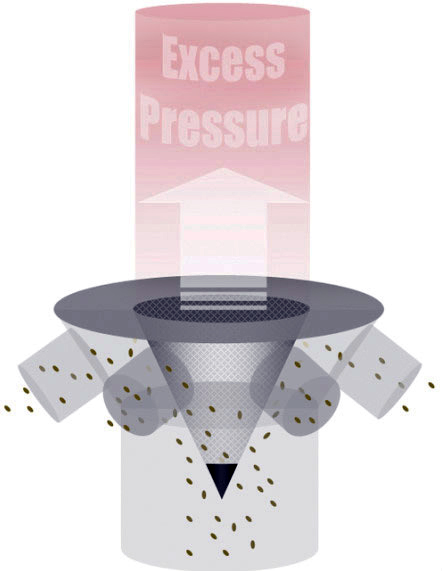If you don’t see what you need, please call us at 785-820-8000.
Are you always battling between too much air from your air drill’s fan, or too little? Too much air because you don’t want to plug the drill’s primaries, or too little air because you’re unhappy with the poor seed placement from too much air? SeedVU gives you the peace of mind of running your air drill’s fan where it should be, and not worrying about seed blowing out of the furrow—and all while monitoring for main line blockages. The SeedVU takes unwanted, excess primary-line air pressure and separates it from the seed and fertilizer stream, right where you need it to: the air drill’s distribution head. This allows seed and fertilizer to travel to your seeder’s openers by gravity, or assisted by an adjustable volume of air. It’s up to you!

SeedVU uses its cone-shaped screens to separate seed and fertilizer from the air stream. Now you can run your air cart fan where it should be, and not have excess air velocity at the seed boot causing more seeds to blow out or bounce out of the furrow from too much push by the air stream.

Older Deere 50/60/90-series air drills with steel distribution heads can be upgraded to the Smallaire head.
SeedVUs fit into the distribution heads, and can be installed (or uninstalled) in a matter of a couple minutes for the entire drill. Quite unlike air diffusers that go into secondary lines so that there’s one for each opener: An all-day job to install, and a nightmare if they ever gunk up from seed treatments or fertilizer dust. The perforated mesh-type air diffusers in secondaries also have issues with very teeny seeds such as teff, an eastern Mediterranean grain crop related to sand lovegrass. When seeding these crops, diffusers must often be removed, or taped over (duct tape fixes anything, right? 🙂
SeedVU is the only device on the market that will stop excess primary-line backpressure, monitor for primary-line blockages, as well as reducing seed bounce. And, let’s face it, all air diffusers eventually have trouble with fertilizer or seed treatments gunking them up. For diffusers that install into secondary lines, this may cause a lot of down-time unplugging them, and in worst-case scenarios might be an all-day job to clean them up. But with SeedVU, it’s a matter of 2 minutes to remove all of them, put the old caps back on, and keep on seeding during crucial time windows. The same goes for ultra-small seeds (e.g., teff) that are unworkable in screen-type diffusers in the secondaries—rather than deal with 36 – 96 of them, just changing out a few SeedVUs has you on your way again!
Note: If you are replumbing your air drill (replacing primary & secondary hoses), try to situate the distribution heads as high as possible, and eliminate droops or horizontalness in all secondaries—this will let you discharge more air pressure from the SeedVUs, or any other diffuser for that matter.
Content of this page is copyright 2005-2025 Exapta Solutions, Inc. (reprint with written permission only).
Thompson wheel covered by U.S. Patent No. 6,907,833. Liquid delivery feature of Valion seed tube guards is U.S. Patent No. 8,978,564. Ninja seed bounce flap U.S. Patent Pending. UniForce U.S. Patent Pending. All rights reserved on other designs. Exapta is a registered trademark of Exapta Solutions, Inc. Keeton is a registered trademark of Precision Planting. Mojo Wire, Thompson wheel, Valion guard, Ninja flap, UniForce, DuraLok, No-till Seeding Explained, and No-till Seeding School are trademarks of Exapta. Disclaimer: Recommendations & page content are current, accurate, and believed to be broadly applicable as of the time of writing (Dec 2005) and last update (2005 – 2014). Because of diversity of soils, climate, crops, planter & drill models/designs marketed worldwide, combinations of attachments, etc., actual results may vary. No warranty is made as to actual results obtained. Should you encounter exceptions or worthwhile annotations to the statements made on this page, please contact us.
Derek is Kansas native who grew up in a 100% no-till farming operation. From an early age the benefits of no-till were made known to Derek by his father and by attending no-till conferences. From there he furthered his passion for soils while at Kansas State University getting his agronomy degree. He has had the experience of working in various roles and sectors of agriculture from sales and consulting to management, which have all been within production agriculture. Derek has also worked in specialty ag markets such as turf and ornamentals.
Sales & Service Representative
Prior to joining Exapta, Bob Pagel was an Agricultural Territory Sales Manager for Ritchie Brothers, serving parts of MN, WI and IA. He continues to support his family farm in SE Minnesota.
Current Product Engineer
Jonathan Zeller joined Exapta excited to return to working with no-till planting equipment. He supported research of no-till planting and other ag related projects for 7 years with Kansas State University’s Agricultural Engineering Department after getting his engineering degree. He later worked 3 years for Landoll Company, LLC. where he gained experience in a design engineering role. Jonathan grew up on a small family farm in NE Kansas working with row crops, hay and cattle. Jonathan enjoys solving engineering problems and improving or creating products to be robust and easy to install and service.